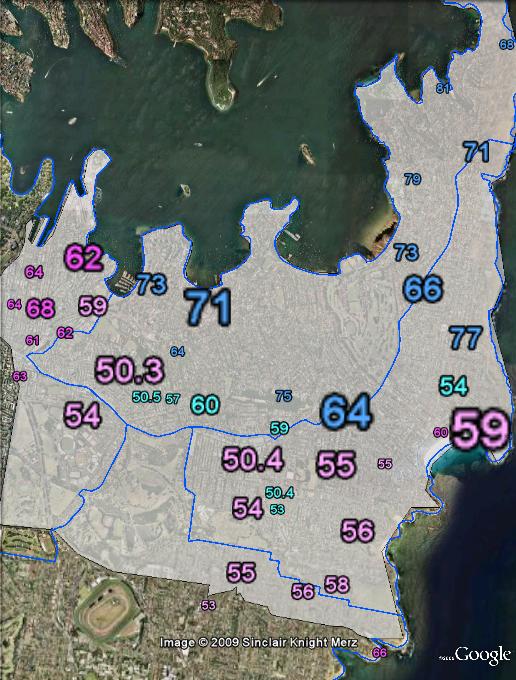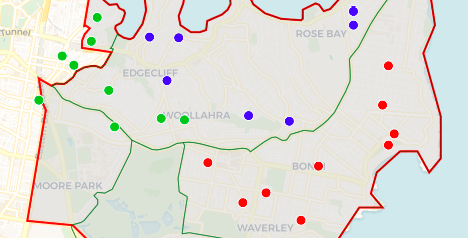When I produce seat guides, I always like to split up the polling places in the electorate into a number of subareas. I find that there are times where you want a sense of the different parts of the seat, but the granular detail of polling places can confuse the broader trends.
Sometimes these subareas represent very clear and distinct divisions in a community, while sometimes they’re more arbitrary. But I think my breakdown of Wentworth reflects some pretty strong differences within the seat which I think will play out on October 20.
I’ve divided this electorate into three areas:
- Harbour – the north-east of the electorate, including the majority of Woollahra council plus Dover Heights in Waverley council.
- Beach – the south-east of the electorate, including most of Waverley council and the parts of Randwick council contained within the electorate.
- City – the west of the electorate, including Paddington, Woollahra, Elizabeth Bay and Rushcutters Bay.
Below the fold, I’m going to explore the differences between these three areas, and how I think these differences could play out in the by-election.
In my seat guide I originally referred to these three areas as Vaucluse, Bondi-Waverley and Paddington, but I think this new nomenclature makes more sense. I originally included Edgecliff, Darling Point and Double Bay in with Paddington (because there was a gap between them and the remainder of the seat) but I now think they probably belong with Harbour. I have updated these categories on my by-election guide.
| Voter group | GRN prim % | LIB 2PP % | Total votes | % of votes |
| Beach | 19.0 | 58.4 | 21,244 | 25.3 |
| Harbour | 9.7 | 79.1 | 18,310 | 21.8 |
| City | 17.7 | 61.3 | 11,563 | 13.8 |
| Other votes | 13.7 | 71.1 | 14,891 | 17.7 |
| Pre-poll | 14.4 | 68.7 | 18,084 | 21.5 |
At first glance you can already see a massive difference in voting patterns. The Liberal two-party-preferred vote is in the low sixties on the beach and near the city, but is creeping close to 80% in the harbourfront suburbs. The Greens came third, and the trend is similar in their vote. They poll under 10% in the harbourfront areas, but around 18% in the rest of the seat.
It’s more interesting when you look at how much each of these areas has shifted over the last decade. The beach and city areas, which have the lower Liberal vote now, experienced larger swings to the Liberal Party over the last three elections.
The following map is from my 2010 election guide, showing the results of the 2007 election. The Liberal vote had crashed in 2004, following Malcolm Turnbull’s preselection victory over Peter King. A redistribution before the 2007 election added more pro-Labor areas close to the city, cutting the notional margin to 2.5%. While Turnbull gained a small swing in 2007, it was still the narrowest margin in Wentworth since the 1940s. So it gives us a good sense of what Wentworth looks like with a weakened Liberal Party.
It’s worth noting that the city and beach areas not only have a lower Liberal vote now: the Liberal vote has grown much more in the beach and city areas since 2007 compared to the harbour area.

So these Beach and City areas have a relatively recent history of being marginal Labor areas. It would not be surprising to see Labor or Phelps overtaking the Liberal Party in these areas, while the harbour areas seem more likely to stay with the Liberal Party.
There’s also some interesting differences between the three areas when you look at some key census datapoints which set Wentworth apart from other areas.
| Voter group | Beach | City | Harbour | Wentworth | NSW |
| Median age | 35 | 37 | 39 | 37 | 38 |
| Renter % | 48.7% | 50.2% | 34.9% | 44.4% | 31.8% |
| Bachelor degree + | 44.9% | 51.9% | 45.9% | 46.8% | 23.4% |
| Managers | 19.5% | 20.6% | 23.3% | 20.8% | 13.5% |
| Professionals | 39.6% | 44.8% | 39.5% | 40.7% | 23.6% |
| No religion | 35.5% | 38.6% | 25.5% | 33.0% | 25.1% |
The harbourfront area has the oldest median age, with a much smaller proportion of the population renting their homes. About half of households in the beach and city areas are renters, compared to just over one third in the harbour area.
All of Wentworth has very high education levels, but the city area is even higher than the rest of the seat.
There are a lot more managers in the harbour area, and a lot more professionals in the city area.
About one quarter of people in the harbour area have no religion – in line with the statewide average – while this group is much larger in the beach and city areas.
I don’t know what will happen on October 20. The polling data isn’t close to accurate enough to split apart these three areas. But I think there’s a good reason to expect the likely drop in the Liberal vote to be concentrated in the beachfront and cityside areas. These areas were not safe Liberal areas prior to Malcolm Turnbull’s consolidation of the seat from 2010-2016, and will be worth watching next Saturday night.




Have you seen the helpful flow chart on how to decide who to vote for in the Wentworth Courier Ben? Across pp 4-5 here: http://newslocal.smedia.com.au/wentworth-courier/
Strong suggestion in it that if you’re well-off but frightened you should vote for Sharma, but anyone who cares about the world’s more general problems should vote Greens, Labor or Phelps. I expect next week’s issue will feature letters from various supporters of the “Liberals” complaining that it’s biased.
Ben this is wonderful analysis. Thank you.
Yes Ben that all makes sense – except that having lived at 2 addresses in Potts Point, 2 in Bellevue Hill, and one each in Bondi, Paddo and Edgecliffe (all years ago), I’d lump Edgecliffe in with Paddo – but certainly leave Darling Point and Double Pay in Harbour!
Great stuff mate.
The swing will be throughout the electorate….
Of course the north harbourside will vote overwhelmingly liberal……. also the top left corner of the 2010 guide map before Rushcutters bay is no longer in the electorate….. the Turnbull influence has improved the lib vote by 10 to 12% ……this will now go. ………also the non harbourside area…has gentrified a little…… think the opinion polls are right within 5%…….if the libs poll under 45% on first preferences they would have reason to worry
I suppose the question comes down to, how much of the shift to the Liberals in the past decade has been Turnbull’s personal vote, and how much is natural change?
It would be interesting to compare the overlapping state results over the past decade or two.
Thank you Ben on this informative post.
Next Saturday will be close, but how close I think will depend on where the Greens finish, as I understand it there are two leading independent candidates, Tim Murray and Dave Sharma considered the main contenders. which brings me to the Greens, if they finish below both independents then any of the four leading candidates could win it, however if the Greens were to finish above the second independent, I am assuming that would be Heath as I think Phelps will come in ahead of the Greens, then I think Phelps or Murray will go on and win although I think Murray is less likely as this isn’t a ALP area.
For Dave Sharma to win he basically has to win on primaries or get over 40% as I cannot see where he will pick up over 10% from, maybe the small business candidate could be one source but I see she has run with an open HTV ticket.
On the lady from the small business party, I have been surprised she hasn’t had a higher profile as she is already a Sydney councilor and has appeared on various ABC programs (I apologise for not checking her name).
John Pyle thanks for the link to Wentworth Courier. It is info like this that makes Tallyroom useful.
Wentworth Courier has a fail grade. There are more than 3 candidates. Whilst National Media may have an excuse for ignoring most of candidates a local newspaper has plenty of space and room to do a full analysis of every candidate.
John Pyke and Andrew Jackson (no relation) I just read the Wentworth Courier and it was about 115 pages long. My two locals are about 35 to 40 pages each. Only two paid add fro two candidates and the flow diagram was interesting but as yuo say only four candidates mentioned (the four stronger candidates I assume).
Comments are closed.